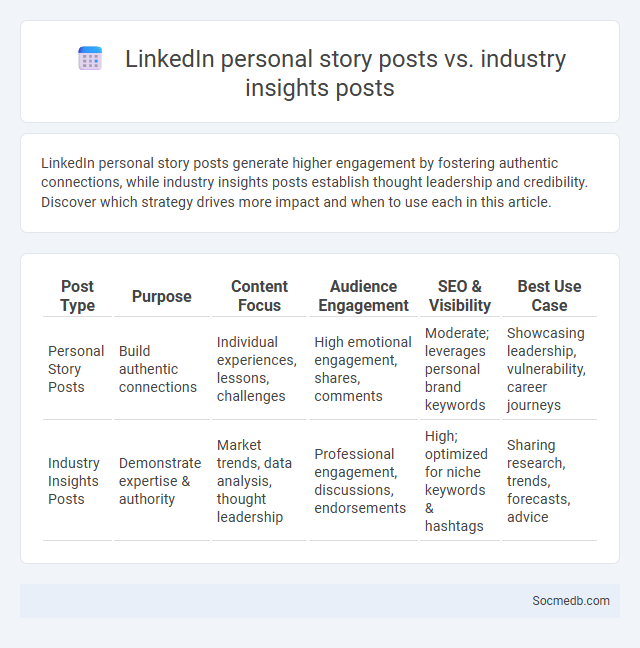
Photo illustration: LinkedIn personal story posts vs industry insights posts
LinkedIn personal story posts generate higher engagement by fostering authentic connections, while industry insights posts establish thought leadership and credibility. Discover which strategy drives more impact and when to use each in this article.
Table of Comparison
| Post Type | Purpose | Content Focus | Audience Engagement | SEO & Visibility | Best Use Case |
|---|---|---|---|---|---|
| Personal Story Posts | Build authentic connections | Individual experiences, lessons, challenges | High emotional engagement, shares, comments | Moderate; leverages personal brand keywords | Showcasing leadership, vulnerability, career journeys |
| Industry Insights Posts | Demonstrate expertise & authority | Market trends, data analysis, thought leadership | Professional engagement, discussions, endorsements | High; optimized for niche keywords & hashtags | Sharing research, trends, forecasts, advice |
Understanding LinkedIn Personal Story Posts
LinkedIn personal story posts enhance professional branding by sharing authentic career experiences that resonate with industry peers. Crafting compelling narratives around challenges and successes increases engagement, fostering meaningful connections within targeted professional communities. Data shows posts with personal stories receive higher interaction rates, boosting visibility and networking opportunities on the platform.
The Impact of Industry Insights Posts on LinkedIn
Industry insights posts on LinkedIn significantly enhance your professional visibility by positioning you as a knowledgeable thought leader within your sector. Engaging with well-researched data and trend analyses increases the likelihood of meaningful connections and opportunities from decision-makers and recruiters. Leveraging these posts strategically can lead to greater brand authority and accelerated career growth in competitive industries.
Content Strategy: Bridging Personal Stories and Professional Insights
Effective social media content strategy seamlessly integrates personal stories with professional insights to foster authentic engagement and build trust. By sharing relatable experiences alongside industry expertise, brands create a compelling narrative that resonates deeply with their audience. This approach enhances audience connection, drives meaningful interactions, and establishes thought leadership in a crowded digital landscape.
Audience Engagement: Stories vs Industry Insights
Audience engagement on social media thrives when your content balances storytelling and industry insights. Stories create emotional connections by showcasing authentic experiences and personal narratives, while industry insights provide valuable, data-driven information that establishes your expertise. Leveraging both approaches ensures your audience remains informed and emotionally invested, boosting interaction and brand loyalty.
Credibility Building Through Industry Insights
Providing accurate industry insights on social media establishes your credibility as a knowledgeable source, attracting a loyal audience seeking trustworthy information. Sharing well-researched data and expert opinions enhances your reputation and encourages meaningful engagement with your content. Your consistent delivery of valuable insights positions you as an authority within your niche, fostering long-term trust and influence.
Humanizing Your Brand with Personal Storytelling
Humanizing your brand through personal storytelling fosters genuine connections by showcasing authentic experiences and values. Sharing relatable narratives engages audiences emotionally, increasing trust and loyalty across social media platforms. Incorporating user-generated content and behind-the-scenes insights enriches brand personality, enhancing overall digital engagement.
Content Frequency: Balancing Storytelling and Insights
Optimal content frequency on social media blends engaging storytelling with valuable insights to maintain audience interest and foster brand loyalty. Posting consistently--ideally 3 to 5 times per week--ensures ongoing visibility without overwhelming followers or diluting message quality. Integrating personal narratives with data-driven information enhances emotional connection while providing actionable value.
Measuring Success: Key Metrics for Both Post Types
Measuring success on social media involves tracking key metrics such as engagement rate, reach, and conversion statistics for both organic and paid posts. Your engagement rate reveals how your audience interacts with content, while reach shows the total number of unique users who see your posts. Conversion metrics, including click-through rates and sales generated, help quantify the direct impact of your social media efforts on your overall business goals.
Content Strategy Tips for LinkedIn Growth
Effective content strategy for LinkedIn growth involves publishing industry-relevant articles and engaging posts consistently to attract your target audience. Utilizing LinkedIn's native features such as polls, videos, and LinkedIn Live enhances interaction and visibility among professionals. Incorporating relevant keywords and hashtags in posts increases discoverability, while actively participating in niche groups fosters networking and authority within your sector.
Creating an Effective Mix: Actionable Steps for LinkedIn Content
Craft a strategic LinkedIn content mix by balancing industry insights, thought leadership, and engaging multimedia such as videos and infographics to boost visibility and interaction. Utilize LinkedIn analytics to identify top-performing posts and optimize content timing based on audience engagement patterns. Incorporate user-generated content and expert opinions to foster trust and build a professional community that drives meaningful connections and business growth.
 socmedb.com
socmedb.com